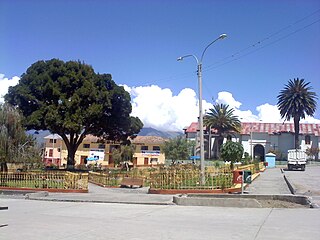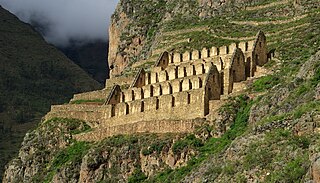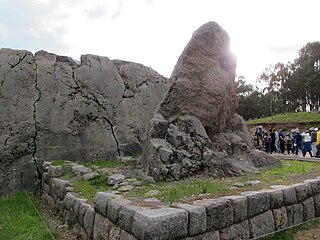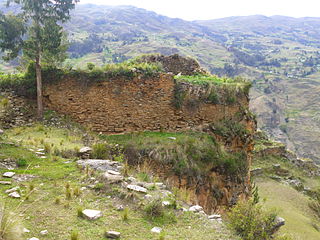Related Research Articles

Chumbivilcas is a province in the Andes in South Peru. The Inca called it "Chumpiwillka". The seat of the province is Santo Tomás. Officially Chumbivilcas was founded on June 21, 1825.

Limatambo District is one of nine districts of the province Anta in Peru.

Mollepata District is one of nine districts of the province Anta in Peru.

Ollantaytambo District is one of seven districts of the province Urubamba in Peru.
Julcamarca District is one of twelve districts of the province Angaraes in Peru.

Q'enqo, Qenko,Kenko, or Quenco is an archaeological site in the Sacred Valley of Peru located in the Cusco Region, Cusco Province, Cusco District, about 6 km north east of Cusco. The site was declared a Cultural Heritage (Patrimonio Cultural) of the Cusco Region by the National Institute of Culture.

Andean Spanish is a dialect of Spanish spoken in the central Andes, from western Venezuela, southern Colombia, with influence as far south as northern Chile and Northwestern Argentina, passing through Ecuador, Peru, and Bolivia. It is influenced principally by Castilian, Canarian and Andalusian Spanish, which is favoured in the cities, but in rural areas and some cities, there is influence of Quechua, Aymara, and other indigenous languages.

Waruq is an archaeological site in Peru. It is situated in the Huánuco Region, Yarowilca Province, Chavinillo District
Rumiwasi or Phaqchayuq is an archaeological site in Peru. It is located in the Cusco Region, Cusco Province, San Sebastián District, north of the central square of San Sebastián.
Pumamarka (Aymara and Quechua puma cougar, puma, marka village, "puma village", is an archaeological park in Peru. It is located in the Cusco Region, Cusco Province, San Sebastián District, on the left side of the river Pumamarka. The site was declared a National Cultural Heritage of Peru by the National Institute of Culture.
Markapukyu is an archaeological site in Peru. It is situated in the Pasco Region, Pasco Province, Yarusyacán District, at a height of 3,787 metres (12,425 ft).
Kunturmarka is an archaeological site in Peru. It is situated in the Pasco Region, Pasco Province, Paucartambo District. The complex consists of round buildings and stone tombs (chullpa).
Collor is an archaeological site in Peru. It is situated in the Cajamarca Region, Cajamarca Province, Namora District. The site lies at a height of about 2,970 metres (9,744 ft) on a mountain named Coyor, east of Lake San Nicolas.
Yanaque - Quilcamarca is an archaeological site in Peru. It is situated in the Ancash Region, Ocros Province, Acas District, at a height of about 3,820 metres (12,533 ft).
Hatun Machay is a rock forest with archaeological remains in Peru. It was declared a National Cultural Heritage by Resolución Directoral No. 944/INC-2010 on May 7, 2010. Hatun Mach'ay is situated on the western side of the Cordillera Negra in the Ancash Region, Recuay Province, Pampas Chico District, at a height of about 4,200 metres (13,780 ft).
Chichakuri is an archaeological site in Peru consisting of stone tombs (chullpa), walls, houses and squares. The place was declared a National Cultural Heritage by Resolución Directoral Nacional No. 296/INC-2003 by the National Institute of Culture on May 16, 2003. Chichakuri is situated in the Puno Region, Carabaya Province, Ollachea District, at a height of about 2,800 m (9,200 ft).
Huankarán is an archaeological site with a rectangular tower, a couple of buildings and stone tombs (chullpa) in Peru. It is situated in the Huánuco Region, Huamalíes Province, Tantamayo District.
Pumawasi (Quechua is a rocky cave with pre-Columbian rock-art in Peru. It is situated in the Cusco Region, Anta Province, Chinchaypujio District. Pumawasi lies in the north of the district, west of the mountain Yuraqqaqa .
Qunchupata is an archaeological zone in Peru. It is located in the Ayacucho Region, Huamanga Province, Ayacucho District. The site was declared a National Cultural Heritage (Patrimonio Cultural) of Peru by Resolución Directional Nacional No. 458-98-INC on December 15, 1998.
Qosqoccahuarina is a private area of conservation in the Urubamba mountain range in the Andes of Peru. It is located in the Cusco Region, Urubamba Province, Ollantaytambo District. It lies in the community of Rumira Sondormayo at the Patacancha valley near Patacancha. The area of conservation of Qosqoccahuarina is recognized by Resolución Ministerial No. 089-2011-MINAM. The aim is to protect the Polylepis forest and its avifauna, the hydrographical basins of the community and the wild flora and fauna of the Andean highlands.
References
- ↑ Teofilo Laime Ajacopa, Diccionario Bilingüe, Iskay simipi yuyayk'ancha, Quechua – Castellano, Castellano – Quechua (Quechua-Spanish dictionary)
- 1 2 mincetur.gob.pe "Sitio arqueológico de Killarumiyoq", retrieved on February 25, 2014
Coordinates: 13°26′42.74″S72°18′35.74″W / 13.4452056°S 72.3099278°W